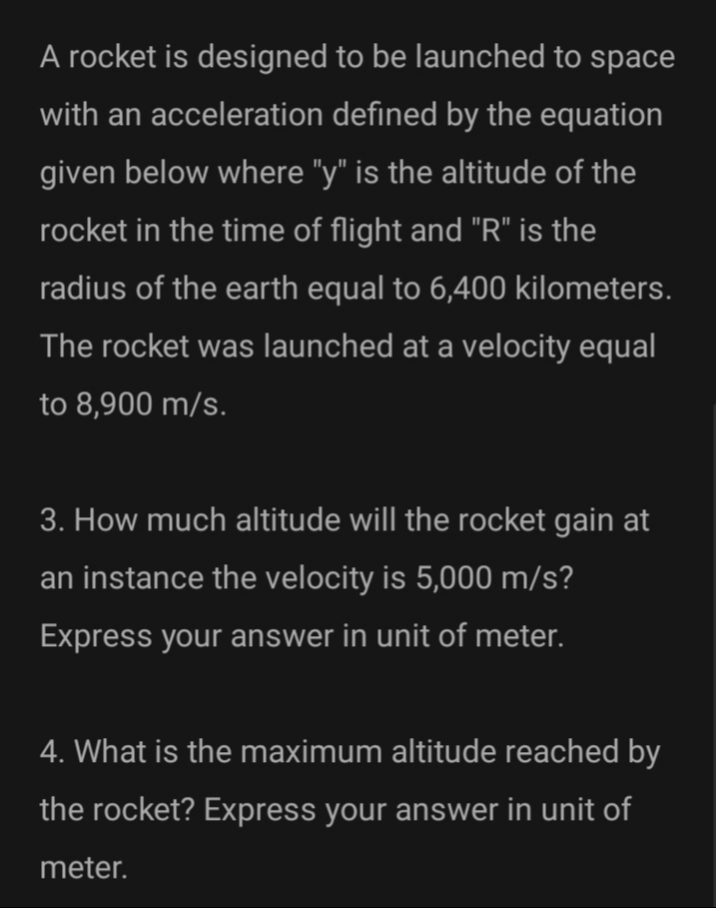A rocket is designed to be launched to space with an acceleration defined by the equation given below where "y" is the altitude of the rocket in the time of flight and "R" is the radius of the earth equal to 6,400 kilometers. The rocket was launched at a velocity equal to 8,900 m/s. 3. How much altitude will the rocket gain at an instance the velocity is 5,000 m/s? Express your answer in unit of meter. 4. What is the maximum altitude reached by the rocket? Express your answer in unit of meter.
A rocket is designed to be launched to space with an acceleration defined by the equation given below where "y" is the altitude of the rocket in the time of flight and "R" is the radius of the earth equal to 6,400 kilometers. The rocket was launched at a velocity equal to 8,900 m/s. 3. How much altitude will the rocket gain at an instance the velocity is 5,000 m/s? Express your answer in unit of meter. 4. What is the maximum altitude reached by the rocket? Express your answer in unit of meter.
University Physics Volume 1
18th Edition
ISBN:9781938168277
Author:William Moebs, Samuel J. Ling, Jeff Sanny
Publisher:William Moebs, Samuel J. Ling, Jeff Sanny
Chapter1: Units And Measurement
Section: Chapter Questions
Problem 33P: In SI units, speeds are measured in meters per second (m/s). But, depending on where you live,...
Related questions
Question
3-4

Transcribed Image Text:A rocket is designed to be launched to space
with an acceleration defined by the equation
given below where "y" is the altitude of the
rocket in the time of flight and "R" is the
radius of the earth equal to 6,400 kilometers.
The rocket was launched at a velocity equal
to 8,900 m/s.
3. How much altitude will the rocket gain at
an instance the velocity is 5,000 m/s?
Express your answer in unit of meter.
4. What is the maximum altitude reached by
the rocket? Express your answer in unit of
meter.
![a = -9.81[R² / (R + y)²]](/v2/_next/image?url=https%3A%2F%2Fcontent.bartleby.com%2Fqna-images%2Fquestion%2Fd81a92ee-1000-4b83-a94c-55bf261d533f%2Fb3b9bf8a-929a-4420-adbf-ef27caa4e37b%2F1otth6n_processed.jpeg&w=3840&q=75)
Transcribed Image Text:a = -9.81[R² / (R + y)²]
Expert Solution
This question has been solved!
Explore an expertly crafted, step-by-step solution for a thorough understanding of key concepts.
Step by step
Solved in 2 steps with 2 images

Knowledge Booster
Learn more about
Need a deep-dive on the concept behind this application? Look no further. Learn more about this topic, physics and related others by exploring similar questions and additional content below.Recommended textbooks for you

University Physics Volume 1
Physics
ISBN:
9781938168277
Author:
William Moebs, Samuel J. Ling, Jeff Sanny
Publisher:
OpenStax - Rice University

University Physics Volume 1
Physics
ISBN:
9781938168277
Author:
William Moebs, Samuel J. Ling, Jeff Sanny
Publisher:
OpenStax - Rice University